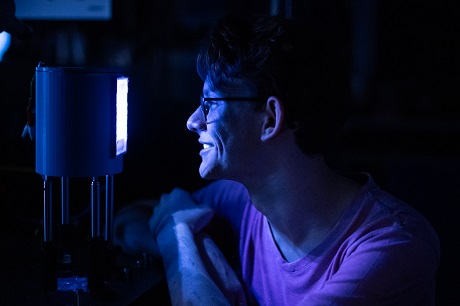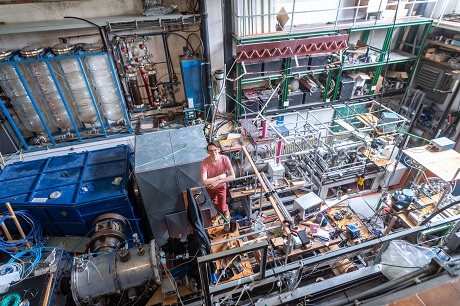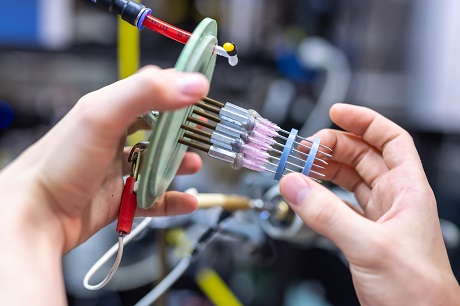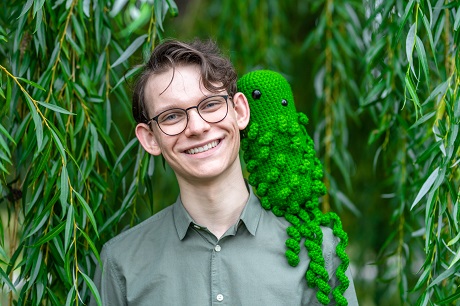
Teen scientist breaks barriers: No child is a lost cause
07. 04. 2025
As a child, Tomáš Čermák couldn’t look people in the eye or easily form relationships. He spent nearly three years in the hospital. But the eighteen-year-old has come a long way since then. Now a graduating high school senior, he is working with the Czech Academy of Sciences, preparing to go study abroad, and racking up one award after another. Most recently, Čermák and nineteen-year-old Anna Podmanická were named European winners of The Earth Prize 2025 for their project PURA, the innovative technology they developed for water purification. On this occasion, we’re showcasing our interview with Tomáš Čermák, first published (in Czech) in the autumn 2024 issue of the popular science magazine of the CAS, A / Easy.
*
You’ve got your high school exit exam coming up at the end of the school year… but you don’t spend time in class with your classmates.
I haven’t actually been attending school for quite a while now – I have an individual study plan. Not primarily because of my scientific work, but originally mainly for health reasons. I’m a diagnosed autistic person, and when I started to study at a selective high school, my health completely collapsed. What followed was basically three years spent in the hospital.
That sounds like a really rough start to your studies.
At eleven, I ended up on IV drips, and I have a complete blackout regarding about six months of my life. Still, I think this extreme experience ended up giving me a lot. It helped me sort out my values in life – and today, I think I have a better sense of what really counts as a problem. And I’ve been working on myself.
So you never went back to school. How do you keep up your education?
I learn independently, on my own. I study subjects in blocks – one week I focus on chemistry, the next on history, and so on. I put together detailed summaries from the studied material and upload them to the website Výpisky.com, which I founded and made freely accessible. I go to school regularly for assessments and exams.
You openly talk about autism – you consider it important for people to know more about it. Can you describe how it affects you?
It changes over time. These days I have no problem looking people in the eye. Six years ago, I wouldn’t have been able to do it. Autistic people do feel emotions, but we might not really understand them at first – our brains work a little differently. For a long time, I found the world incomprehensible, as if I’d fallen to Earth from Planet Autistan.
And yet here I am, talking to a smiling, communicative young man.
That transformation took years of therapy. And also years of watching people – how they behave, the expressions they make when they talk. To me it felt unnatural to look people in the eye or shake their hands. But I realized it was going to be a necessary part of communication.
So you tried to imitate others?
I used the trial-and-error method. Of course, I don’t want to speak for all autistic people, but some of us are a bit like artificial intelligence. We’re very quick learners, soaking up everything around us like sponges. As a child I had serious issues, and at one point, no one would have probably guessed I’d ever function normally. I think it’s incredibly important to say this: No child is a lost cause!

Even a high school student can work at the Czech Academy of Sciences. One way is through the Open Science internship program, but Tomáš forged his own path to the Institute of Plasma Physics of the CAS – he simply reached out to the researchers there.
You’re living proof of that. You haven’t even graduated high school yet, and you’re already involved in the scientific community and have experience working with two research institutes of the Czech Academy of Sciences (CAS), no less: the Institute of Plasma Physics of the CAS and the Institute of Physics of the CAS. What drew you to physics in particular?
It provides answers about how the world around us works. But I’ll be totally honest: if my first encounter with physics had only been through a school textbook, I might never have gotten into it. I completely get anyone who doesn’t like physics in school. I get that having to memorize “formulas out of nowhere” can turn a lot of people off the subject.
Where did your interest in science come from?
I’ve always had a curious mind and a passion for discovering new things. But what really sparked my interest was a university-level Advanced Placement (AP) course offered in the Czech Republic by the Center for Talented Minds. The course is taught online in English. I’ve taken four AP exams in total – two in physics, one in economics, and another in calculus.
So how did you go from online courses to doing research at the Institute of Plasma Physics of the CAS?
At the start of the COVID pandemic, there was a huge problem with an initial shortage of respirators. I started looking into whether there were any ways to sterilize them, and I found out that cold plasma could potentially be used for that. It inspired me, and I began assembling a small device intended for this purpose at home. But at a certain point, I hit a wall – I didn’t know how to continue, so I set the project aside. Then I picked it up again, only to set it aside again...
But the idea didn’t stay on ice forever.
About a year and a half ago, I realized I wanted to revisit the topic. I started digging into the available academic research literature and decided to reach out to associate professors working in plasma physics here in the Czech Republic. That’s how I got in touch with Tomáš Homola from the Institute of Plasma Physics of the CAS.

Student Tomáš Čermák in the lab at the Institute of Plasma Physics of the CAS (autumn 2024).
Respirator disinfection could probably be done in other ways too – so why plasma?
Respirators are made of very sensitive materials that are tricky to sterilize. Most chemical methods, for instance, can damage the nanofibers, while UV light can’t reach the tiniest gaps in the material, so it only disinfects the surface... That means we need a method that doesn’t generate high heat or pressure, so it doesn’t degrade the material. And cold plasma fits the bill.
What exactly is it? Is there such a thing as hot plasma too?
There are two basic types of plasma. The first is called equilibrium plasma, because the activated particles in it are in thermal equilibrium with their surroundings – this is hot plasma, and stars are an example of that. Then there’s non-equilibrium (or nonthermal) plasma, where the particles aren’t in balance, and this type of plasma can easily be at room temperature. That’s called cold plasma.
For your device, you used a type of plasma discharge called a corona discharge. What should we picture here?
It’s a type of electrical discharge in gases that forms at highly curved regions of electrodes. In the reactor I built, I use the tips of medical needles to generate a corona discharge. The corona is visible to the naked eye – it looks like a faint glow around the needle tips. If you’re lucky, you can sometimes catch a glimpse of a corona discharge on high-voltage power lines during thunderstorms.
Your original goal was to create a device for disinfecting respirators. Did it work out?
For this project, I set four goals. The first was to construct the device itself, the second was to characterize the physics of the corona discharge, the third focused on bacteria, and the fourth on wastewater. In the research phase, I defined certain phenomena associated with corona discharges in alternating current – for instance, why its performance drops in the presence of water, or why it increases when the amount of gas rises.
What did you find out about the bacteria?
It turns out the device really can be effective at killing bacteria. It’s capable of destroying about ninety-eight percent of bacteria in three minutes! I also identified how the corona affects bacteria – twenty-five percent of the effect is from UV radiation. The output gases in the corona have a negligible effect – less than five percent.
And what about its potential for treating wastewater?
We tested the device on over a hundred substances – things like analgesics, antibiotics, and antidepressants. For some of them, the results were quite impressive. After ninety seconds of plasma treatment, the water sample contained seventy-five percent less sulfonamide antibiotics, sixty percent less of the anesthetic ketamine, and seventy percent less sertraline, which is used to treat depression. (Note: This is the core of Čermák’s award-winning PURA project – it involves purifying water of pharmaceuticals and pollutants using a combination of plasma and photocatalysis).

Prototype of the device that Tomáš Čermák developed and tested at the Institute of Plasma Physics of the CAS.
So would your invention actually be able to clean the respirators that started off this whole journey?
So far, all our experiments have been done using aqueous solutions with bacteria and other substances in Petri dishes. It would be possible to place the respirator itself into the device, but it’s not something we’ve tried in this phase of the research yet. We have to design an experiment in a way that will yield measurable results. We need to be able to reliably measure what the device does to both the respirator and the microorganisms it contains.
You started building the first version of the device at home, but the final prototype was developed in the lab at the Institute of Plasma Physics of the CAS. How much work went into it?
I was constructing the reactor last summer [2024], alternating between home and the lab. In autumn, I dove into determining the physical characteristics of the corona, running experiments, taking measurements, and so on. From September to December, I spent an estimated two hundred hours in the lab. I got a lot of help during the experimental part from Jiří Fujera, a PhD student working with Tomáš Homola.
Do you think other students have a shot at getting involved with top research institutions at such a young age?
In theory, yes. The opportunity is there for anyone, but it takes enormous stamina, discipline, and the courage to risk rejection. Someone once told me it was rude to reach out to associate professors directly, but I stand by my approach – because honestly, I doubt they would’ve contacted me. (laughter)
High school students can also get involved in research thanks to the Otevřená věda (Open Science) student internship program run by the Czech Academy of Sciences. You took part in that too.
It’s a great program for students who are interested in science but don’t know where to start. You just have to keep in mind that you might not get an internship on your first try – it’s better to apply to several research institutes at once.
|
Try Open Science! Are you a high school student and want to do an internship at one of the institutes of the Czech Academy of Sciences? Try Otevřená věda (Open Science)! You can choose from topics across a range of research fields. Applications open every year in November. The well-established program has been running for twenty years, and some of its earliest interns are now full-fledged scientists and even Open Science mentors. Learn more (in Czech) here: https://www.otevrenaveda.cz/cs/staze-pro-studenty/ |
You ended up doing an internship at the Institute of Physics of the CAS. But the topic you’re working on there seems quite distant from plasma and respirator sterilization, right?
It is different, but I’m really excited about it, and the work is incredibly fulfilling. We’re exploring the use of artificial intelligence in physics and designing neural networks that function similarly to the human brain. We’re developing a program that will be capable of detecting ECG anomalies in real time and diagnosing heart disorders. (Note: The Open Science internships always run from January to December, so Tomáš’s internship ended at the close of 2024. The team really did manage to develop a program capable of diagnosing cardiac anomalies.)
Would you be interested in a future at the Czech Academy of Sciences, or are you more drawn to studying and doing research abroad?
I think we’re incredibly lucky to have an institution like the Czech Academy of Sciences here in the Czech Republic. It has a strong tradition, great results, and brings together amazing minds. I see a lot of potential in it for connecting research with industry, and I’d be very interested in working there. Right now, though, I’m applying to universities abroad – including Cambridge, MIT, Harvard – so we’ll see what happens. (Note: Tomáš has been accepted to Imperial College London.)
Given your earlier health issues which meant you couldn’t attend classes at school, how did you actually end up learning English?
At first, my English wasn’t that great, but I read books in English and watched YouTube in English. Things really took off when I started watching videos in the original English with English subtitles – after that, I picked up the language super fast.
Is there a school subject that just doesn’t click with you, or one you struggle with? What about history, for example?
Honestly, I enjoy pretty much everything in some way. Even history. I try to see high school as a great opportunity to get a taste of every field. It’s true I had a bit of trouble with music class, but even there you can find something valuable – like the historical context.
Okay, but is there anything you really can’t stand?
Sports! (laughter) I consider myself a total sports anti-talent. I just don’t find playing sports relaxing – so I found a different way to unwind and clear my mind. Last year, when everything got a bit too much, I started to make friendship bracelets, then learned to crochet, make bobbin lace, and embroider. I even crocheted a research mascot – a giant E. coli bacterium. I find crafting incredibly relaxing. I can just sit there crocheting and it calms me right down. (smiling)
|
TOMÁŠ ČERMÁK
He studies remotely at the Biskupské gymnázium (high school) in Hradec Králové. In his free time, he constructed a device capable of inactivating microorganisms and purifying water pollutants using cold plasma. He worked on its construction in the lab of the Institute of Plasma Physics of the CAS and received The Learned Society of the Czech Republic Award for Research (for secondary school students) in May 2024. In 2024, he completed an internship with the Open Science program at the Institute of Physics of the CAS, where he contributed to the development of a neural network that can diagnose heart disorders from ECG data in real time. He won first place in the 2023 Energy Olympics with a project on using green algae to capture CO2 and convert it into electricity and received the Duke of Edinburgh’s International Award for a scientific expedition to the Žďárské vrchy (Žďár Hills) Protected Landscape Area, where he measured soil radiation with a gamma spectrometer he built himself. In 2024, he stood out in the Czech High Schooler of the Year competition with his project Výpisky.com and was named TECH Talent of the Year. In early April 2025, he was honored by the National Institute for Autism (NAUTIS) for helping improve public understanding of autism. He co-founded the STEM_HUB association, which now connects over 250 students with an interest in STEM (Science, Technology, Engineering, and Mathematics). In April 2025, Tomáš Čermák and Anna Podmanická were named the European winners of The Earth Prize for their water purification project. They became the first-ever recipients of this award from the Czech Republic and Slovakia, earning a grant of 12,000 EUR to advance their project. From 13 April 2025, the public will be able to vote and determine the global Earth Prize winner out of the regional finalists. |
Our interview with Tomáš Čermák first came out (in Czech) in the CAS magazine A / Easy 2 / 2024.
Written and prepared by: Leona Matušková, External Relations Division, CAO of the CAS
Translated by: Tereza Novická, External Relations Division, CAO of the CAS
Photo: Jana Plavec, External Relations Division, CAO of the CAS
 The text and photos are released for use under the Creative Commons license.
The text and photos are released for use under the Creative Commons license.
Read also
- Renewables are a strategic investment in European security, scientists say
- New record set for neutrino mass: one million times less than an electron
- On the trail of the endangered little owl: searching for newly hatched owlets
- The Czech Academy of Sciences has appointed its new leadership for 2025–2029
- Literature is tied to its historical context. How can we read between the lines?
- Radomír Pánek: The Academy must be united, strong, and proactive
- A springtime booster: The healing potential of tree buds
- A novel compound that protects bone cells may benefit diabetic patients
- New interactive exhibition at the CAS showcases materials shaped by genius ideas
- Leaf growth, root formation, and reproduction – Look to hormones for the answer
The Czech Academy of Sciences (the CAS)
The mission of the CAS
The primary mission of the CAS is to conduct research in a broad spectrum of natural, technical and social sciences as well as humanities. This research aims to advance progress of scientific knowledge at the international level, considering, however, the specific needs of the Czech society and the national culture.
President of the CAS
Prof. Eva Zažímalová has started her second term of office in May 2021. She is a respected scientist, and a Professor of Plant Anatomy and Physiology.
She is also a part of GCSA of the EU.
